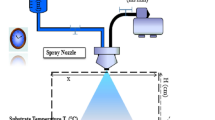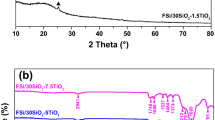Abstract
Sol–gel spin coating technique was used to deposit thin films of ZnO, SnO2, and ZnO/SnO2 on a borosilicate glass substrate. The films were characterized using XRD, FESEM, EDX, HRTEM, AFM, UV-Vis spectrophotometer, and contact angle meter. X-ray diffraction confirms the presence of both hexagonal wurtzite and tetragonal phase of ZnO and SnO2 respectively in ZnO/SnO2. Wettability studies reveal that ZnO/SnO2 film is superhydrophilic with water contact angle of 3.4°. The photocatalytic performance of the films is evaluated by measuring the degradation of an aqueous solution of methylene blue, methyl orange, and their mixture. The degradation of stearic acid adsorbed on the film’s surface is measured by tracking the water contact angle after UV irradiation as a function of time. The excellent photocatalytic activity of ZnO/SnO2 thin films is attributed to formation of type-II heterostructure between ZnO and SnO2, which inhibits the charge recombination between photogenerated electrons and holes. The ZnO/SnO2 shows good photocatalytic activity after five recycling runs. ZnO/SnO2 thin films being excellent photocatalyst along with its superhydrophilic nature will have potential application in self-cleaning and antifogging.

Highlights
-
SnO2, ZnO and ZnO/SnO2 thin films were prepared by a cost-effective sol-gel method.
-
ZnO/SnO2 thin films show superhydrophilic character.
-
Degradation of pollutants in solid and liquid phase was evaluated.
-
ZnO/SnO2 shows superior photocatalytic activity due to heterostructure formation.














Similar content being viewed by others
References
Fujishima A, Zhang X (2006) Titanium dioxide photocatalysis: present situation and future approaches. Comptes Rendus Chimie 9:750–760.
Krishna MG, Madhurima V, Purkayastha DD (2013) Metal oxide thin films and nanostructures for self-cleaning applications: current status and future prospects. Eur Phys J Appl Phys 62:30001
Drelich J, Chibowski E, Meng DD, Terpilowski K (2011) Hydrophilic and superhydrophilic surfaces and materials. Soft Matter 7:9804–9828
Feng L, Li S, Li Y, Li H, Zhang L, Zhai J, Song Y, Liu B, Jiang L, Zou D (2002) Super-hydrophobic surfaces:From natural to artificial. Adv Matter 14:1857–1860
Feng X, Feng L, Jin M, Zhai J, Jiang L, Zhu D (2004) Reversible super-hydrophobicity to super-hydrophilicity transition of aligned ZnO nanorod films, photoinduced superhydrophilicity and photocatalytic properties of ZnO nanoplatelets. J Am Chem Soc 126:62–63
Okada K, Tokudome Y, Falcaro P, Takamatsu Y, Nakahira A, Takahashi M (2012) Titanate nanofunnel brushes: toward functional interfacial applications. Chem Commun 48:6130–6132
Barreca D, Gasparotto A, Maccato C, Tondello E, Stangar UL, Patil SR (2009) Photoinduced superhydrophilicity and photocatalytic properties of ZnO nanoplatelets. Surf Coat Tech 203:2041–2045
Papadopoulou EL, Barberoglou M, Zorba V, Manousaki A, Pagkozidis A, Stratakis E, Fotakis C (2009) Reversible photoinduced wettability transition of hierarchical ZnO structures. J Phys Chem C 113:2891–2895
Langlet M, Permpoon S, Riassetto D, Berthome G, Pernot E, Joud JC (2006) Photocatalytic activity and photo-induced superhydrophilicity of sol–gel derived TiO2 films. J Photoch Photobio A 181:203–214
Simonsen ME, Li Z, Sogaard EG (2009) Influence of the OH groups on the photocatalytic activity and photoinduced hydrophilicity of microwave assisted sol–gel TiO2 film. Appl Surf Sci 255:8054–8062
Padmavathy N, Vijayaraghavan R (2008) Enhanced bioactivity of ZnO nanoparticles-an antimicrobial study. Sci Technol Adv Mater 9:035004
Wang C, Chu X, Wu M (2006) Detection of H2S down to ppb levels at room temperature using sensors based on ZnO nanorods. Sens Actuat B-Chem 113:320–323
Moafi HF, Shojaie AF, Zanjanchi MA (2011) Photocatalytic self-cleaning properties of cellulosic fibers modified by nano-sized zinc oxide. Thin Solid Films 519:3641–3646
Behnajady MA, Modirshahla N, Hamzavi R (2006) Kinetic study on photocatalytic degradation of C.I. Acid Yellow 23 by ZnO photocatalyst. J Hazard Mater 133:226–232
Talinungsang, Purkayastha DD, Krishna MG (2018) Dopant controlled photoinduced hydrophilicity and photocatalytic activity of SnO2 thin films. Appl Surf Sci 447:724–731
Liu Y, Koep E, Liu M (2005) A highly sensitive and fast-responding SnO2 sensor fabricated by combustion chemical vapor deposition. Chem Mater 17:3997–4000
Wang W, Zhu Y, Yang L (2007) ZnO–SnO2 hollow spheres and hierarchical nanosheets: hydrothermal preparation, formation mechanism. Adv Funct Mater 17:59–64
Cun W, Jincai Z, Xinming W, Bixian M, Guoying S, Pingan P, Jiamo F (2002) Preparation, characterization and photocatalytic activity of nano-sized ZnO/SnO2 coupled photocatalysts. Appl Catal B-Environ 39:269–279
Wang C, Wang X, Xu B, Zhao J, Mai B, Peng P, Sheng G, Fu J (2004) Enhanced photocatalytic performance of nanosized coupled ZnO/SnO2 photocatalysts for methyl orange degradation. J Photoch Photobio A-Chem 168:47–52
Zhang M, An T, Hu X, Wang C, Sheng G, Fu J (2004) Preparation and photocatalytic properties of a nanometer ZnO–SnO2 coupled oxide. Appl Catal A 260:215–222
Modirshahla N, Hassani A, Behnajady MA, Rahbarfam R (2011) Effect of operational parameters on decolorization of Acid Yellow 23 from wastewater by UV irradiation using ZnO and ZnO/SnO2 photocatalysts. Desalination 271:187–192
Hamrouni A, Lachheb H, Houas A (2013) Synthesis, characterization and photocatalytic activity of ZnO-SnO2 nanocomposites. Mater Sci Eng B 178:1371–1379
Liu R, Huang Y, Xiao A, Liu H (2010) Preparation and photocatalytic property of mesoporous ZnO/SnO2 composite Nanofibers. J Alloy Compd 503:103–110
Uddin Md, Nicolas Y, Olivier C, Toupance T, Servant L, Muller M, Kleebe H, Ziegler J, Jaegermann W (2012) Nanostructured SnO2−ZnO heterojunction photocatalysts showing enhanced photocatalytic activity for the degradation of organic dyes. Inorg Chem 51:7764–7773
Lamba R, Umar A, Mehta SK, Kansal SK (2015) Well-crystalline porous ZnO–SnO2 nanosheets: an effective visible-light driven photocatalyst and highly sensitive smart sensor material. Talanta 131:490–498
Upadhaya D, Talinungsang, Kumar P, Purkayastha DD (2019) Tuning the wettability and photocatalytic efficiency of heterostructure ZnO-SnO2 composite films with annealing temperature. Mat Sci Semicon Proc 95:28–34
Zhou M, Yu J, Liu S, Zhai P, Jiang L (2008) Effects of calcination temperatures on photocatalytic activity of SnO2/TiO2 composite films prepared by an EPD method. J Hazard Mater 154:1141–1148
Kaneva N, Stambolova I, Blaskov V, Dimitriev Y, Vassilev S, Dushkin C (2010) Photocatalytic activity of nanostructured ZnO films prepared by two different methods for the photoinitiated decolorization of malachite green. J Alloy Compd 500:252–258
Wenzel RN (1936) Resistance of solid surfaces to wetting by water. Ind Eng Chem 28:988–994
Chen Y, Zhang Y, Shi L, Li J, Xin Y (2012) Transparent superhydrophobic/superhydrophilic coatings for self-cleaning and anti-fogging. Appl Phys Lett 101:033701
Chen Y, Zhang C, Huang W, Yang C, Huang T, Situ Y, Huang H (2013) Synthesis of porous ZnO/TiO2 thin films with superhydrophilicity and photocatalytic activity via a template-free sol–gel method. Surf Coat Tech 258:531–538
Rezayi T, Entezari MH (2016) Wettability property varies with different morphologies of ZnO nanpoarticles deposited on glass and modified by stearic acid. New J Chem 40:2582–2591
Owens DK, Wendt RC (1969) Estimation of the surface free energy of polymers. J Appl Polym Sci 13:1741–1747
Enesca A, Isac L, Duta A (2013) Hybrid structure comprised of SnO2, ZnO and Cu2S thin film semiconductors with controlled optoelectric and photocatalytic properties. Thin Solid Films 542:31–37
Xu Y, Schoonen MAA (2000) The absolute energy positions of conduction and valence bands of selected semiconducting minerals. Am Mineral 85:543–556
Zhang L, Jaroniec M (2018) Toward designing semiconductor-semiconductor heterojunctions for photocatalytic applications. Appl Surf Sci 430:2–38
Acknowledgements
The authors would like to thank the Science and Engineering Research Board, India, for financial assistance through a research project (YSS/2014/000133). The authors would also like to thank to Dr Sarathi Kundu of Institute of Advanced Study in Science and Technology, Guwahati, SAIF, IIT Bombay, and Central Manufacturing Technology Institute, Bangalore, for providing an experimental facility to take AFM, FESEM, and nanoindentation studies respectively.
Author information
Authors and Affiliations
Corresponding author
Ethics declarations
Conflict of interest
The authors declare that they have no conflict of interest.
Additional information
Publisher’s note Springer Nature remains neutral with regard to jurisdictional claims in published maps and institutional affiliations.
Rights and permissions
About this article
Cite this article
Talinungsang, Upadhaya, D., Kumar, P. et al. Superhydrophilicity of photocatalytic ZnO/SnO2 heterostructure for self-cleaning applications. J Sol-Gel Sci Technol 92, 575–584 (2019). https://doi.org/10.1007/s10971-019-05127-8
Received:
Accepted:
Published:
Issue Date:
DOI: https://doi.org/10.1007/s10971-019-05127-8




